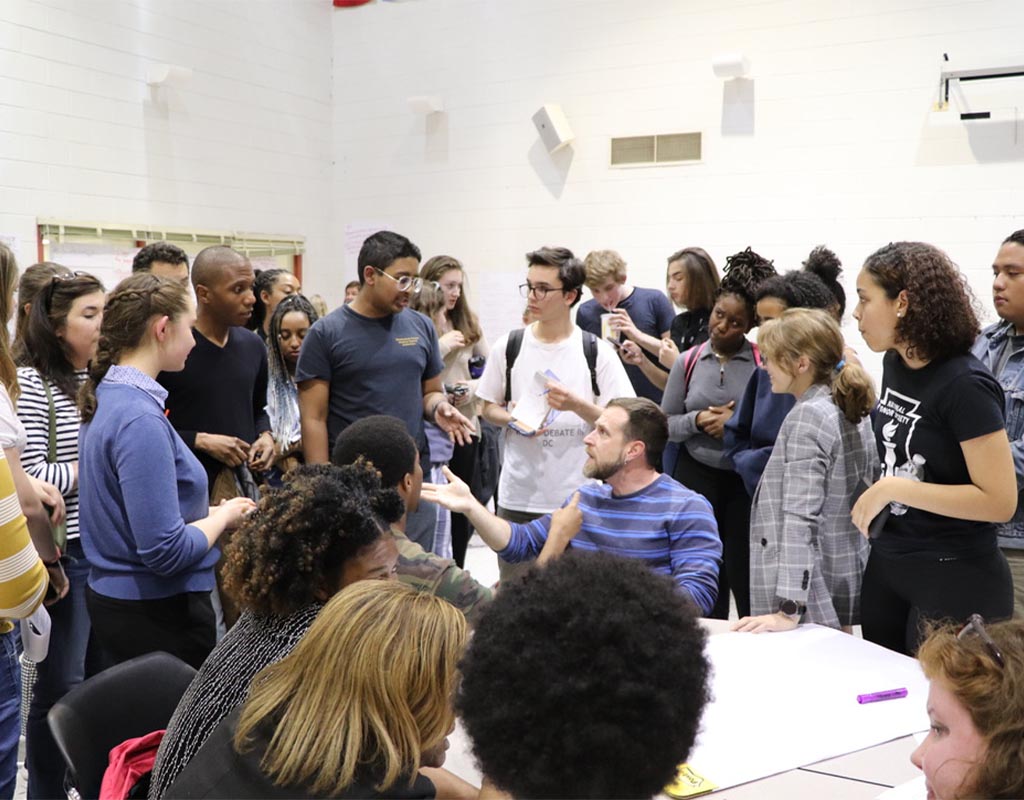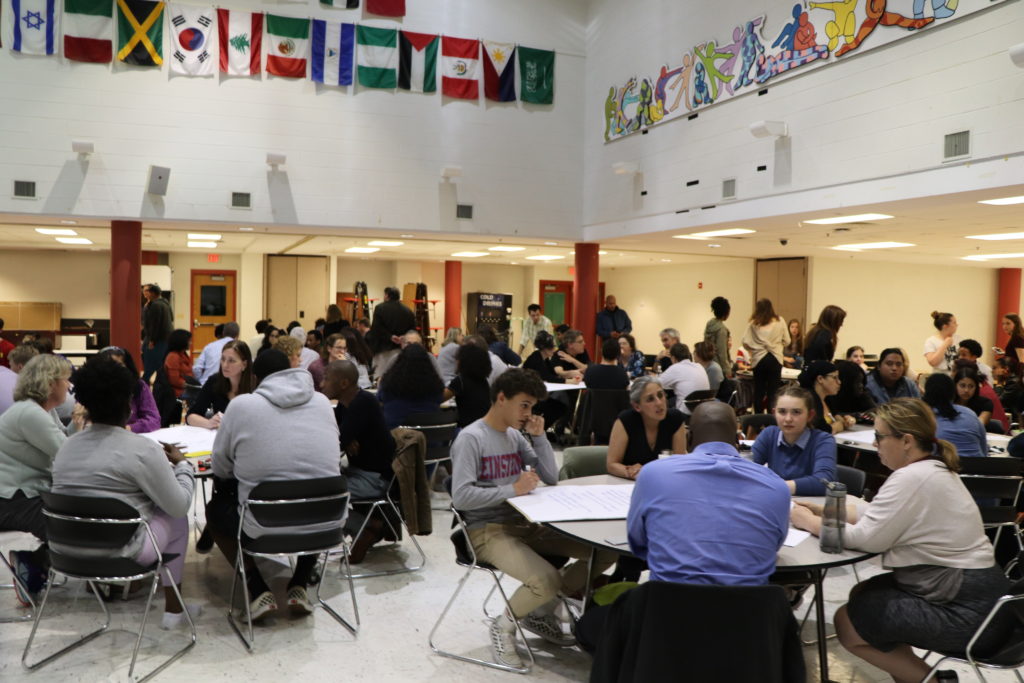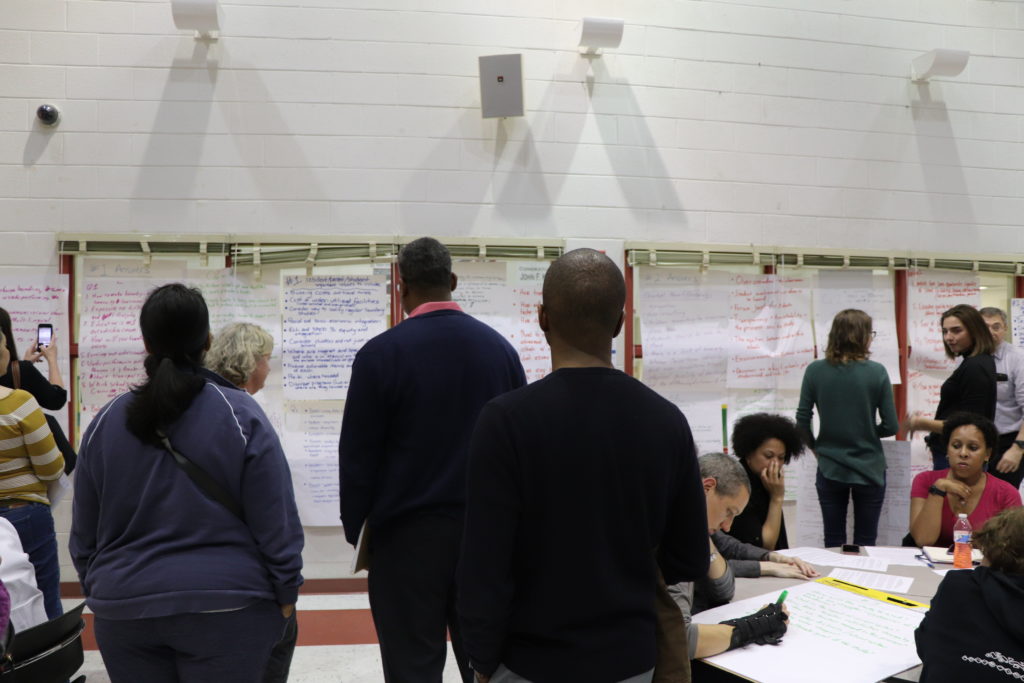
Community Members Divided Over Montgomery School Boundary Analysis
More than 100 Community Members Offer Feedback on School Boundaries at Kennedy High School
Montgomery County Public Schools’ second boundary assessment community conversation at John F. Kennedy High School in Silver Spring brought out students activists, parents, and teachers.
Derek Turner, a spokesperson for MCPS, estimates that between 65 to 70 people attended the first community conversation at Quince Orchard. But after a Bethesda Beat article describing polarizing conversations and debates on school boundaries, about 115 people showed up at Kennedy High Wednesday night.
Sofi Gizaw of Silver Spring, an MCPS parent, said she heard about this meeting after reading the Bethesda Beat article.
Gizaw said, “I think there [were] some parent comments that were not aware of the other side — some ignorance, where some parents say you know if those students come to us, they’re not going to be able to perform or do well. So, I felt like there was a lack of knowledge on the other side, so I thought the discussion was a good opportunity to come and make your voice heard.”
The conversations are intended to serve as a way for the Board of Education to receive community input about a January resolution that “calls on the superintendent of schools to engage, using an external consultant, in an in-depth review and analysis of how existing [MCPS] school and cluster boundaries support or impede the effective use of school facilities.”
Turner said, “This is a way for us to […] think about the other factors in [the school board’s] FAA policy, which include geography, demographics, and sustainability, [and] whether people move around a lot and having to move school to school.”
The feedback from the meeting is used to help determine the scope of the consultant’s analysis. Turner says that the consultant will be hired in “May or June.”
MCPS Community is Asked Three Key Questions About Reviewing the Boundaries
At the Kennedy High conversation, people sat at circle tables with a poster pad and markers. Everyone at each table was each given a sheet of paper with three questions:
- As a resident and/or parent, what issues are important to you to include in a review and analysis of school and cluster boundaries?
- If you could advise the consultant who will be conducting the MCPS boundary analysis, what would you tell the consultant are the greatest concerns among parents about the current attendance zones?
- What do you want to learn from the boundary analysis?
At the beginning of the event, the facilitator instructed the groups to take 30 minutes to write down the answers to these discussion questions on a large poster.
After the facilitator asked the group if anyone had any questions a man stood up talked about how he also attended the first meeting and there was “nothing substantive” that came out of the meeting. Since the meeting was in a cafeteria, a lot of what the man said was inaudible, but he spoke for about a minute as the crowd shouted back at him to “stop lobbying,” “just write it down,” and others wondered why a moderator wasn’t preventing this.
Boundary Analysis Study Causing Division in Montgomery County
Earlier this week, The MoCo Show published a poll on Facebook and Twitter, asking county residents how they feel about school boundaries.
The results on the Facebook poll were close:
https://www.facebook.com/MoCoShow/posts/1915779815192635
The Twitter poll received more votes, and also had more options. Its results revealed that the majority of voters agree that change — to varying degrees — is needed when it comes to school boundaries.
Earlier this year the MCPS Board of Ed. decided it would hire an outside consultant to study school boundaries in order to explore ways to evenly distribute student populations throughout the county.
How do you feel about school boundaries?
— The MoCoShow (MCS) (@TheMoCoShow) April 9, 2019
People who attended the meeting came with strong opinions.
Gizaw said she’s interested in knowing how much wealth in the community currently influences the boundaries.
“I lived in Norway and Denmark before I came to the U.S., where it doesn’t matter where you live, you get the same quality education,” said Gizaw.
Gizaw said she’d like this analysis to help education be fairer to all students.
“The amount of wealth that you make [shouldn’t] influence [a] public school at all,” she said.
Stacy Small-Lorenz of Wheaton, who plans to send her children to MCPS, said that she’s interested in seeing some concrete data come of this analysis.
“I’ve really been trying to understand why there is such a glaring achievement gap in different parts of the county that seems to clearly correlate with economics and property values and my hope is that this boundary study is going to start providing some data so we can make data-based decisions that can help truly close the achievement gap,” said Small-Lorenz.
In one group discussion, a man who chose to remain anonymous argued that boundaries needed to stay centered on a “community” where students could be in close proximity to their schools. He said he found the”entire boundary analysis study” to be biased.
The man said, “Social re-engineering by way of changing school boundaries does not address the root problems causing the underlying achievement gap.”
A woman who was in this man’s small group, and also chose to not identify herself, left the meeting and said she was “saddened” by how her discussion went.
Students Lead Conversation About Racial Equity
Others were more hopeful about their group discussions. One common thread throughout the evening was that students walked around and sat at different tables joining in the discussion.
Gizaw said that two seniors from Bethesda joined her table and talked about attending a school that they feel lacks social and economic diversity.
Many of the students in attendance were involved in the group MoCo Students for Change.
We know many people have some questions regarding the boundary study, and we also know that the information isn’t always readily available. So, we’ve done our best to answer some of those questions.
We need everyone to show up to the upcoming community conversations! pic.twitter.com/hzexCAMqBN
— MoCo Students For Change (@moco4change) April 9, 2019
An April 6 post on MoCo Students For Change’s Facebook page called on students to come to the event to advocate for “no more de-facto segregated schools.”
The post says, “We’re not asking for bussing, and we’re not threatening property values. We just want this study to address a historic, systemic issue. Our public education system is supposed to serve EVERY community equally. The concerns of families in Potomac should have the same weight as those of families in Wheaton.”
Nate Tinbite, president the county-wide SGA and a MoCo Student For Change founding member, said that the group was there to engage in all sides to the conversation through “healthy discussion.”
Other students who were asked for comment declined.
At one point in the evening, more than 20 students gathered around the man who stood up before the small group discussion. It’s clear that the man had an opposing viewpoint from the students about the boundary assessment, but the conversation was inaudible.
The man declined to give comment once he finished speaking with the students.
https://www.instagram.com/p/BwIOgOshbWd/
Jill Ortman-Fouse, a former school board member, posted on her Facebook page on Thursday afternoon that she felt some adults were disrespectful to the students.
“Can’t stop thinking about how disrespectful some adults were to the teens’ perspectives, positions and experiences last night. And they did it with smiles on their faces. The teens maintained their dignity in spite of the complete disconnects,” said Ortman-Fouse.
Other adults, like Vic Miller and Dinah Sparks of Potomac, came out to the event to support the students.
Sparks, whose daughter is the present of MoCo Students for Change, felt the dialogue in her group was respectful.
“I am glad it didn’t turn into some big, loud nightmare, which is maybe why the small groups are helpful,” said Sparks.
Miller said that he was happy to see the students “feel empowered to take things in their own hands and speak up.”
“[My group included] a good mix of students and parents and people from all over the county, so we had a good exchange, and we talked about the value of diversity in all forms of life and how we can have greater diversity with a better school mix, the some of the downsides of the current boundaries are the way that they’re drawn and the inequities that flow from that,” said Miller.
Parents, Students Answer Three Questions About Boundary Analysis
Here’s a recap of the event in Tweet form. The tweets include posters with all the notes from group discussions.
As some background, @mocoboe requested that @MCPS’s superintendent use “external consultants to conduct an in-depth review an analysis of how existing school and cluster boundaries support or hinder the effective use of school facilities in MCPS.”
— Deirdre Byrne (@DeirdreByrne_) April 10, 2019
Here’s the paper that everyone has received. pic.twitter.com/ImtNTkEMJ9
— Deirdre Byrne (@DeirdreByrne_) April 10, 2019
Every table is supposed to take thirty minutes to answer each of the three questions on the sheet.
— Deirdre Byrne (@DeirdreByrne_) April 10, 2019
Here’s some answers to question #1. pic.twitter.com/umcprZ3Yxz
— Deirdre Byrne (@DeirdreByrne_) April 10, 2019
More answers to question #1. pic.twitter.com/7ocLUk3Qxj
— Deirdre Byrne (@DeirdreByrne_) April 10, 2019
Another set of responses to question #1. pic.twitter.com/MVlLrtLwTr
— Deirdre Byrne (@DeirdreByrne_) April 11, 2019
The second question is, “If you could advise the consultant who will be conducting the @MCPS boundary analysis, what would you tell the consultant are the greatest concerns among parents about the current attendance zones?”
— Deirdre Byrne (@DeirdreByrne_) April 11, 2019
More answers to the second question. pic.twitter.com/Ub7oG3wYys
— Deirdre Byrne (@DeirdreByrne_) April 11, 2019
The third question is: What do you want to learn from the boundary analysis. Here are some answers. pic.twitter.com/PSdKGo1O8B
— Deirdre Byrne (@DeirdreByrne_) April 11, 2019
Here are the final answers to question number three. pic.twitter.com/8SYlFdIDOr
— Deirdre Byrne (@DeirdreByrne_) April 11, 2019



i am a 75-y-old educated woman living in senior housing in Silver Spring…1 of my grandsons attends a local elementary school…i would like information about how the “consultant” will be hired…the consultant job should be posted in the same manner as any other BoE job in the county…a public announcement should be made by the BoE…there should be an open competition for this job…related to this, in all the radio, media, & person-to-person coverage i’ve received about the meetings regarding the BoE study, i have not heard ANY references to scientific studies…there are MANY…in short, we need open publicity about the hiring process for the consultant position, and we need a consultant who is knowledgeable about the scientific literature!…thank you for your attention to this post…sincerely, clara b. jones
Ms. Byrne: …please see this article by David Armor, an area Emeritus Professor…i think Armor should be considered for the MoCoBoE “boundary study” consultant position…as stated in a previous comment, i think the process of hiring this consultant should be a transparent and open one…sincerely, clara b. jones
https://www.brookings.edu/blog/brown-center-chalkboard/2016/08/23/bringing-back-busing-do-benefits-outweigh-cost/